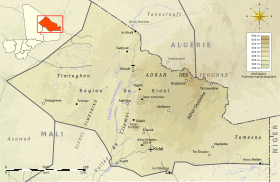The Adrar des Ifoghas (also Adrar des Iforas; Tamasheq: ⴰⴷⵔⴰⵔ ⵏ ⵉⴼⵓⵖⴰⵙ in Tifinagh; Adrar n Ifoghas; Arabic: أدرار إيفوغاس Ifoghas' Mountains) is a massif located in the Kidal Region of Mali, reaching into Algeria. It has an area of around 250,000 square kilometers (97,000 square miles).
| Adrar des Ifoghas | |
|---|---|
| Adrar n Ifoghas | |
 View of a guelta near Oubankort | |
| Highest point | |
| Elevation | 890 m (2,920 ft) |
| Geography | |
| Location | Central Sahara |
| Countries | |
| Regions/Provinces | |
Geography
editThe Adrar des Ifoghas area is characterized by wide, shallow valleys and is strewn with piles of eroded granite blocks. The massif's valleys open to the Tamesna plain on the east, to the Telemsi fosse on the west, to the western basin of the Azaouak valley on the south and to the Tanezrouft on the north. Settlements of the area include Kidal, Aguel'hoc, Boghassa, Essouk and Tessalit.
The Adrar des Ifoghas is known locally as "Adagh". "Adrar" is the Berber word for mountain, while "Ifogha" is the name of an aristocratic Tuareg clan, "Kel Ifoghas", who have dominated the region for generations. Like most Tuareg, the Kel Ifoghas are nomadic, raising camels, goats and sheep for sustenance and for sale.
The area is rich in archaeological remains, particularly rock drawings which depict men hunting, farming and cattle-rearing.[1] The skeleton of Asselar man (c. 6,400 BP) was also found in the area by Wladimir Besnard and Théodore Monod.[2] The Adrar des Ifoghas has also become popular for treks.
Mosques of the Adrar des Ifoghas
editResearch by Patrice Cressier[3] provides insight into the architectural and cultural significance of four mosques in the Adrar des Ifoghas, north of Gao and Agadez.
The mosque of Tefis, probably built around 1480, occupied a central position in an oval sacred enclosure and was accompanied by a small fifteenth-century oratory. Another notable mosque in the town of In-Teduq, founded around 1430 by ʿUthman al-Mawhub bin Iflawas, had a central structure divided into three aisles aligned with the qibla. Unfortunately, it was destroyed by violence in the mid-sixteenth century.
Similarly, the mosque of Shi-n Wasagharan, characterised by two aisles parallel to the Qibla, dates from the sixteenth century, based on epigraphic evidence from nearby necropolises. Meanwhile, the mosque of Es-Suk, located in the medieval city of Tadmekka, had a rectangular hall measuring 23.5 by 15.5 metres and divided into five aisles parallel to the qibla.[4]
These mosques typically followed a north-south rectangular plan, with narrow aisles aligned with the qibla and strong walls pierced by small openings. While some villages or temporary settlements had only one nave, urban centres such as Assode or Tadmekka had three naves. Unlike mosques in Mauritania, those in Air lacked ornamentation and had a more substantial appearance, without minarets or minbars.
Cressier suggested that the meticulous spatial organisation of these mosques, structured along an east-west axis and often integrated into sacred oval enclosures, reflected a sense of divine harmony influenced by Sufism. In addition, scholars from Tadmekka established hermitages in Air in the late fifteenth century, which probably contributed to the unique religious architecture of the region. These mosques represent a distinct subset within the pre-Saharan steppe, characterised by their orientation to the qibla and two or three parallel aisles.
Recent history
editIn 2013, the rugged badlands became a refuge for Islamist fighters fleeing French intervention in the Mali civil war.[5] On 22 February, a battle was fought in Adrar des Ifoghas, killing 25 Chadians, including Abdel Aziz Hassane Adam, the leading Chadian special forces commander in Mali, and 93 Islamists. On 12 March, a battle took place in the village of Tigharghar, killing one Chadian soldier and 6 Islamists. The battle resulted in the Chadians taking the village.
References
edit- ^ Velton, Ross (2000). Mali: The Bradt Travel Guide. London: Bradt Publications. p. 169.
- ^ Bassey W. Andah; Alex Ikechukwu Okpoko (2009). Foundations of Civilization in Tropical Africa. Concept Publications. p. 107. ISBN 978-9788406037. Retrieved 15 June 2016.
- ^ Cressier, Patrice. "Archéologie de la dévotion soufi." Journal des africanistes 62.2 (1992): 69-90.
- ^ Nixon, Essouk - Tadmekka. An Early Islamic Trans-Saharan Market Town (2017): 108-110.
- ^ Adam Nossiter; Peter Tinti (9 February 2013). "Mali War Shifts as Rebels Hide in High Sahara". The New York Times. Retrieved 10 February 2013.
Further reading
edit- Karpoff, R.; Chavaillon, N.; Alimen, H. (1963), "Nouveaux gisements paléolithiques dans l'Adrar des Iforas (Sahara)", Bulletin de la Société préhistorique de France (in French), 60 (5–6): 352–363.
- This article was begun from a translation from the corresponding French article, accessed 17 December 2005.
External links
edit- Media related to Adrar des Ifoghas at Wikimedia Commons

